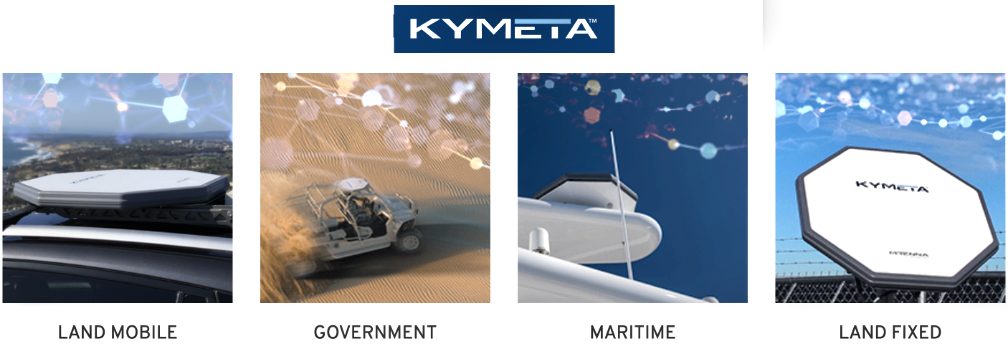
Kratos Defense & Security Solutions, Inc. (Nasdaq: KTOS) has engaged in a strategic partnership with Kymeta to jointly develop products and solutions that will enable modern, virtualized, ground systems to better leverage the capabilities of next generation, mobile, satellite antennas.

Among the broader goals of the partnership are to advance the ability of ground systems to support, leverage, manage, and control electronically-steered and multi-purpose antennas to better support the capabilities of software-defined and multi-beam satellites. This effort will initially focus on joint development of a software-defined remote terminal that will support a variety of dynamic satellite connectivity applications, including support for multi-orbit use cases where connectivity to LEO, MEO, and GEO satellites through the same antenna are desirable.

The space industry is immersed in a renaissance, driven by technology breakthroughs such as smallsats, proliferated LEO constellations, software-defined payloads, multi-orbit services, and more. On the ground, commensurate advances in satellite networks are occurring, as witnessed by the growth of ground-as-a-service providers, mobile communications-on-the-move, and virtualized ground systems. These advances at both ends of the space/ground connection mean that satellite systems must come to act more dynamically, adapting on-the-fly to changing needs, conditions, service levels, and business or mission requirements.
The Digitally-Transformed Remote Terminal will combine a Kymeta ESA with a software-defined uCPE (Universal Customer Premises Equipment) based on Kratos OpenSpace technology, all in a unified terminal package. The OpenSpace Platform is the first and only commercially available software-defined and orchestrated ground system that allows satellite and communications operators to advance the digital transformation of their satellite networks.

In order to deliver a solution that dynamically adapts to changes at the space layer while also supporting multiple functions at the network’s edge, the jointly developed products will conform to industry standards, including the IEEE-ISTO Std 4900-2021: Digital IF Interoperability Standard, v1.0 from the Digital IF Interoperability (DIFI) Consortium (DIFI). Both companies believe that common standards are essential for the space industry to realize the opportunities on the horizon and to advance the industry’s integration with the larger global communications infrastructure. Both are founding members of DIFI, an independent organization created to develop and promote standards for interoperability in space and satellite systems.

According to Greg Quiggle, Vice President of Space Product Management at Kratos, “This modem/antenna interface assumes an analog, static, one-for-one relationship at a time when the space layer has evolved to include highly dynamic multi-orbit networks and software-defined payloads. Remote terminals must digitally transform, embracing the unique capabilities of electronically steered antennas (ESA) and universal customer premise equipment (uCPE) to dynamically enable multi-beam, multi-band, and multi-use at the network edge.”
“Kymeta is excited to partner with Kratos, a leader in the space network virtualization revolution, to jointly develop a digital ground terminal that leverages the Kymeta u8 antenna technology,” said Lilac Muller, Kymeta’s Vice President of Product Management. “The Kymeta u8 is a software-defined platform that unlocks the potential of future capabilities in both terrestrial and space-based networks in geostationary and non-geostationary orbits.”
Additionally, Kratos is enhancing their Earth Observation & Remote Sensing Service Chain (EO/RS SC) for their OpenSpace Platform. The new release adds features that enable satellite operators and Ground Station-as-a-Service (GSaaS) providers to increase automation, accelerate deployment times and further optimize operating and capital expenditures.
The OpenSpace Platform is the first fully virtualized and orchestrated satellite ground system. Service chains, such as the EO/RS SC, run on the OpenSpace Platform to seamlessly integrate and automate the tasks of service delivery in a fully virtual environment. The new release of the EO/RS SC enables customers to support the current and next generation of EO/RS satellites by providing fully orchestrated Telemetry, Tracking, and Command (TT&C), high-throughput wideband data downlink and packet processing of mission data.
Kratos’ OpenSpace family of solutions enables the digital transformation of satellite ground systems to become a more dynamic and powerful part of the space network. The family consists of three product lines: OpenSpace SpectralNet for converting satellite RF signals to be used in digital environments; OpenSpace quantum products, which are virtual versions of traditional hardware components; and the OpenSpace Platform, the first commercially available, fully orchestrated, software-defined ground system. These three OpenSpace lines enable satellite operators and other service providers to implement digital operations at their own pace and in ways that meet their unique mission goals and business models.
Addressing the intensive bandwidth needs of today’s missions, the EO/RS SC delivers more than a gigabit-per-second of downlink throughput. It does so running solely on commercially available, off-the-shelf x86-based computers without specialized hardware or enhancements. Operators can deploy and reconfigure these service chains in minutes running in public cloud, private data center environments or hybrid cloud environments.
“The new, enhanced capabilities of the OpenSpace EO/RS SC and the ability to orchestrate those functions within the OpenSpace Platform dramatically lower the cost of downlinks, while raising the performance for missions,” said Christopher Boyd, Senior Director of Product Management at Kratos. “Virtual TT&C modems, wideband receivers, and stream processing/recorders are orchestrated as a service chain along with the automated configuration of physical functions such as digitizers and antenna control systems to support fully automated EO sensing mission services from the antenna all the way to post satellite pass processing.”
